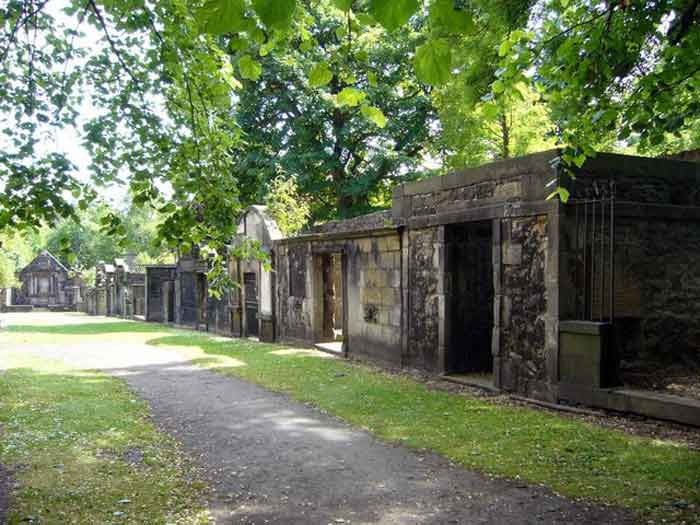
Covenanters’ Prison.
Unusual things to see in Edinburgh are more common than you might think.
With over 4,000 historic buildings and a multitude of other attractions, exploring the city can seem a daunting prospect, particularly if you’re only planning a short stay.
While Edinburgh Castle, the Palace of Holyroodhouse and some of the other best-known monuments should be on every itinerary, Scotland’s capital city has an unconventional face with secret places and often overlooked treasures waiting to be explored.
So don’t forget about the more unusual things to do in Edinburgh? While they are all worth visiting, some of them do tell a painful story but together are an integral part of Edinburgh’s history.
1) The Thistle Chapel in St Giles’ Cathedral
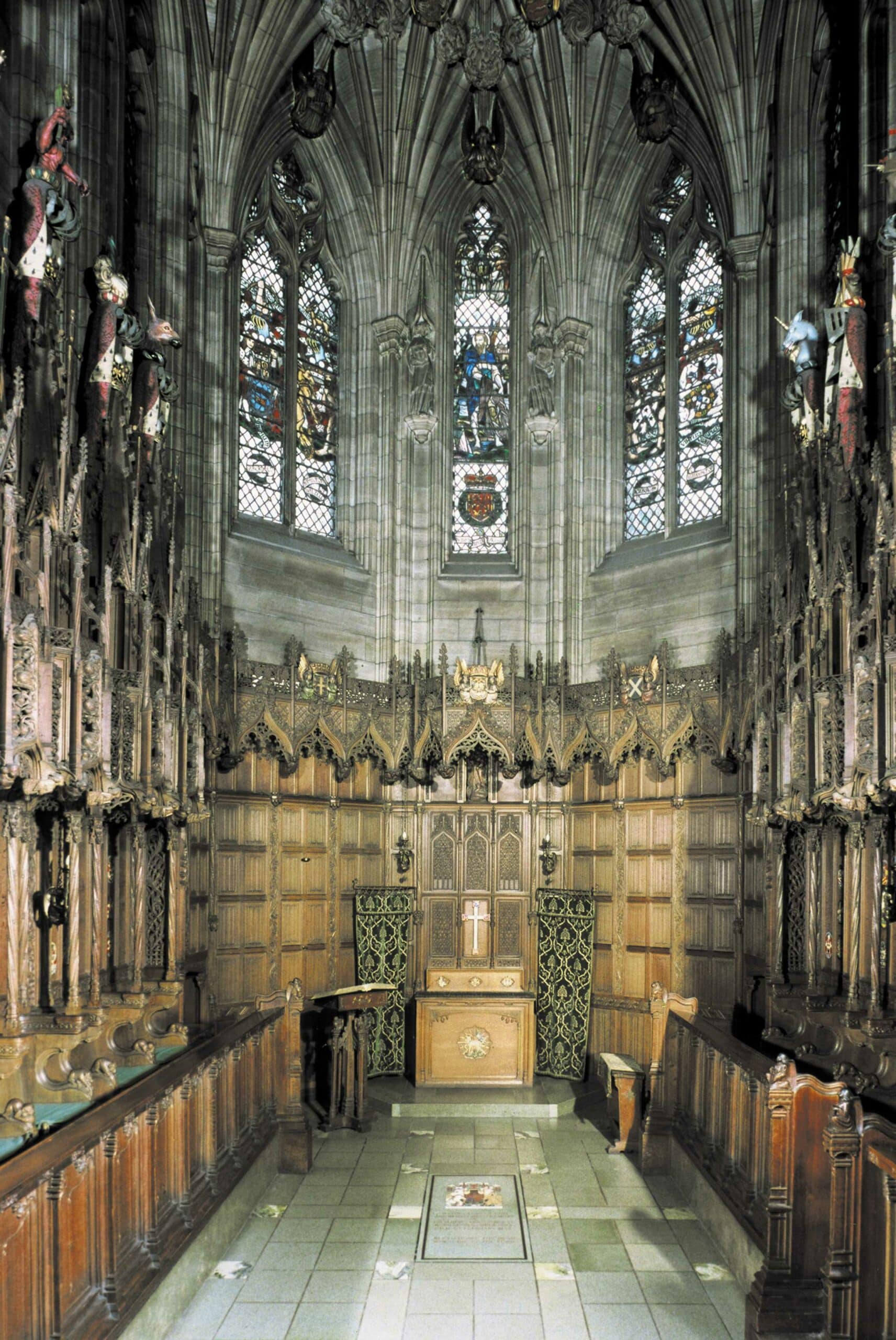
The Thistle Chapel in St Giles’ Cathedral, built in 1911, is tucked away at the east end of the Preston Aisle. It’s a beautiful part of the building named after Sir William Preston.
Preston reportedly brought back an arm bone, said to be of the much-venerated St Giles, from France in 1454.
Lined with intricately carved knight’s stalls and a sovereign’s stall, the chapel is topped with the most magnificent ceiling.
The chapel is littered with heraldic and religious symbolism, much of it Scottish in nature. The angels playing the bagpipes are the highlight for many.
The exquisite, if very small, chapel serves as the home on ceremonial occasions for the 16 knights, appointed by the monarch.
They are members of the Order of the Thistle, Scotland’s greatest order of chivalry.
St Giles’ Cathedral is located towards the top of the Royal Mile, not far from Edinburgh Castle.
This feature article on Truly Edinburgh says more about St Giles’ Cathedral.
2) Covenanters’ Prison
After the Battle of Bothwell Bridge in 1679, over a thousand Covenanter prisoners were locked up in terrible conditions in Greyfriars Kirkyard, in Edinburgh’s Old Town.
While some died there, some were subsequently deported to the American colonies and others were executed for treason.
While this part of the kirkyard is usually kept locked, there are occasional tours and when I asked at the adjacent Greyfriars Kirk, they kindly opened up just for me. I found it an evocative place to explore.
This feature article on Truly Edinburgh says more about Greyfriars Kirkyard and the Covenanter’s Prison.
3) The Covenanters’ Memorial
On the edge of the Grassmarket, part of Edinburgh’s Old Town, a roughly cut raised disc with a granite circle and Saltire cross provides a poignant reminder of Scotland’s often brutal religious struggles.
This simple memorial marks the site of the public gallows where many Covenanters were put to death, between 1661 and 1668, for their beliefs.
The inscription which surrounds the memorial reads, “Many Martyrs and Covenanters died for the Protestant faith on this spot.”
4) The Archivist’s Garden
Edinburgh’s Archivist’s Garden might well be described as an oasis of peace in the heart of a busy city. Entrance to the garden is free.
This little-known garden is located close to the east end of Princess Street, between General Register House and New Register House which hold the National Records of Scotland (NRS).
The garden is planted with 57 species, each one associated with Scotland’s history through folklore, heraldry, myth, tartan, birth, marriage and death, homecoming and famous Scots.
It’s a lovely city centre space, packed with colour and texture. It’s a fascinating place to explore.
The NRS website has all the details about the garden including opening times.
5) Entrance to the University of Edinburgh’s New College
I’ve included this one simply because as you step through the entrance, the view is so unexpected.
But don’t be surprised to see a rather stern John Knox surveying the scene.
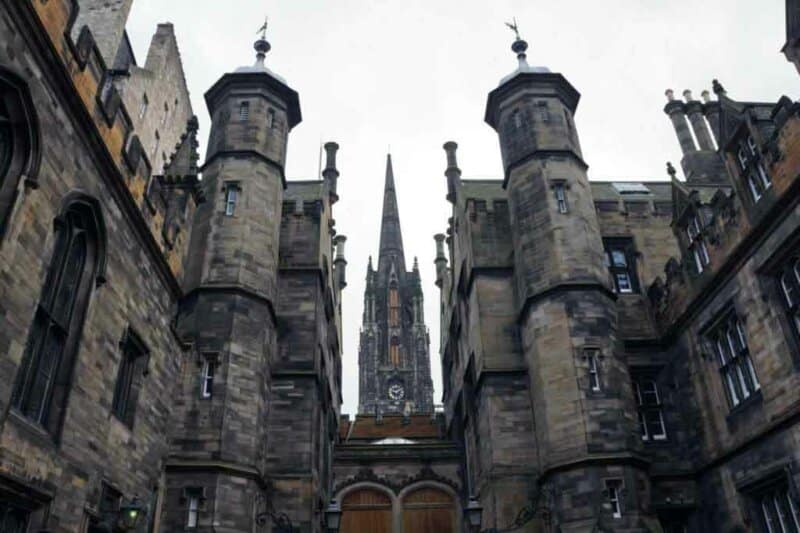
New College was founded in 1846, following the ‘Disruption’, a schism in the Church of Scotland. Today the college is the site for the School of Divinity. Within New College, the General Assembly Hall is home to the annual General Assembly of the Church of Scotland
You’ll find the college on the Mound which is close to the Royal Mile. To learn more about Edinburgh University’s history see my article on Truly Edinburgh.
6) Nelson Monument
To find a monument in Edinburgh dedicated to Admiral Lord Nelson, who died at the Battle of Trafalgar in 1805, may come as a bit of a surprise to you. But completed in 1816, it is now a familiar feature of the Edinburgh skyline.
Initially, the monument had a tenant who established a small restaurant and thanks to its prominent position it also proved handy for sending messages across the city.
However, in 1852, a time ball was installed at the top of the tower and would drop exactly at one o’clock as a signal to the ships on the Firth of Forth, allowing captains to check the accuracy of their chronometers.
While it sounded like a good idea at the time, the fact that there was only a visible signal and not an audible one meant that it just wasn’t practical on a foggy day.
In 1861, the One O’clock Gun firing from Edinburgh Castle replaced the time ball.
Bearing in mind that the monument already sits on top of Calton Hill, the extra 147 steps to the top of the tower will take you to one of the best views in Edinburgh.
7) St Mary’s Episcopal Cathedral
Just off the well-worn tourist trail in the west end of Edinburgh, St Mary’s Episcopal Cathedral, with its three Gothic spires is, not so unusual, but just a lovely place to visit.
The Cathedral’s interior boasts a number of artistic treasures, among them a hanging rood (cross) with the figure of Christ shown crucified against a background of Flanders poppies.
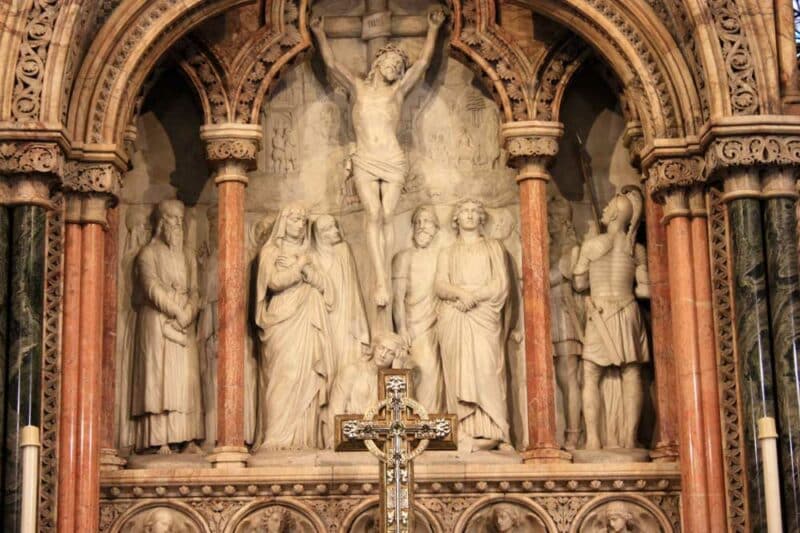
The cross, which was initially intended for the National War Museum in Edinburgh Castle, marks the division between choir and nave.
Also, the magnificent high altar is flanked by statues of St Columba and St Margaret, wife of Malcolm III, king of Scotland.
St Margaret’s Chapel, the oldest surviving building in Edinburgh is named after this remarkable woman.
This feature article on Truly Edinburgh has more information.
8) Holyrood Abbey ruins
Holyrood Abbey, founded by King David I in 1128 stands in the grounds of the Palace of Holyroodhouse at the bottom of the Royal Mile.
There are some wonderful stories attached to the abbey building, many of them rooted in legend. One of them tells that the king built the abbey in memory of a golden cross which contained part of the ‘true cross’ owned by his mother Margaret wife of Malcolm III.
When composer Felix Mendelssohn arrived at the abbey in 1828, he noted,
“Everything was ruined, decayed and open to the sky.”
Felix Mendelssohn
And that’s pretty much the way it remains today, one of my favourite unusual things to see in Edinburgh.
A number of royals are buried in the abbey choir including David II, James II, and James V, Mary Queen of Scots father.
This feature article on Truly Edinburgh has more information.
9) The Magdalen Chapel
The Magdalen Chapel stands on Edinburgh’s Cowgate. Although it’s part of the Old Town, it’s definitely not the prettiest part. But don’t let that put you off.
It was the last Roman Chapel to be constructed (1541-44) in Edinburgh before the Reformation and for that reason alone it’s worth visiting. But there’s so much more. The fact that it was a woman, Janet Rynd who was the real driving force behind the chapel and accompanying almshouse adds to the story.
There are associations with Mary Queen of Scots and her mother Mary of Guise and the Incorporation of Hammermen a prominent Edinburgh trade body.
Inside, the only intact remaining pre-Reformation stained glass window and the same simple table used to lay out executed Covenanters before they were dressed in their grave clothes and buried at nearby Greyfriars Kirkyard.
To learn more about Magdalen Chapel see the feature article on Truly Edinburgh.
10) The Statue of Abraham Lincoln
A statue of former American president Abraham Lincoln is not something you might expect to see in Scotland’s capital city.
But the Emancipation or Lincoln Monument, unveiled in August 1893 is located in Edinburgh’s Old Calton Burial Ground. It commemorates the Scottish-American soldiers who fought on behalf of the Union in the American Civil War.
The memorial, complete with a bronze shield and American flag wreathed in thistles stands over a slave being released from his shackles
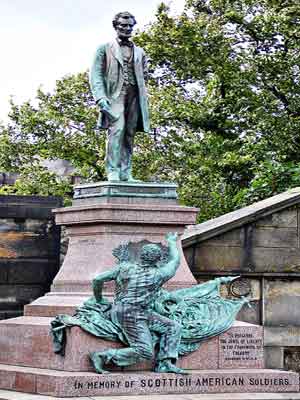
The names of six Edinburgh residents who took part in the conflict are inscribed on the memorial.
Although the Lincoln Monument, the only one to a US president in Scotland, is particularly poignant others who lie in the burial ground also have a story to tell.
They include philosopher David Hume, a leading Enlightenment figure, whose striking mausoleum is adjacent to Lincoln.
The feature article on Truly Edinburgh says more about the Old Calton Burial Ground.
11) Miniature Coffins
In 1836, three young boys, searching for rabbits, found a cache of miniature coffins hidden in a small hollow on Arthur’s Seat in Edinburgh.
Seventeen coffins, only a few in length, were filled with little carved wooden figures.
But what were they and what did they mean?
The coffins, only eight have survived, are now on display in the National Museum of Scotland (NMS) in Edinburgh.
The Museum whose experts have long pondered over their meaning asked were the coffins:
“Satanic spell, superstitious charm or echo of Edinburgh’s grisly underworld history….”
anon
The National Museum of Scotland tells the story of what they call the mystic coffins.
12) Scottish Genealogy Society Family History Centre
The Scottish Genealogy Society doesn’t often find itself in a list of unusual things to do in Edinburgh.
However, given the interest that many people have in researching both family and wider Scottish history, it’s not surprising that people make good use of the Society library (open six days a week) and its host of resources.
The Family History Centre is sited at Victoria Crescent which looks down on the colourful bow-shaped Victoria Street in Edinburgh’s Old Town.
You will get all the details on the official Scottish Genealogy Society website.
13) The Cockburn Geological Museum
If you’ve been to Dynamic Earth, close to Holyrood Park, a fascinating venue that tells the story of the creation of the planet we all live on, then a visit to the Geological Museum might seem like a natural place to move on to.
Part of the University of Edinburgh School of Geosciences, it looks also at how, from a geological perspective, the Earth was formed.
The Museum holds a vast collection of fossils, meteorites, minerals and other historical objects.
Visitors are welcome but you do have to make a prior arrangement.
“The Museum demonstrates Edinburgh’s prominent position in geological sciences since the time of James Hutton (1726-1797).”
Cockburn Geological Museum
The official Cockburn Geological Museum website has all the details.
14) Surgeons’ Hall Museums
This is a museum with a difference, three museums to be precise.
- The Wohl Museum
- The History of Surgery Museum
- The Dental Collection
The museums are owned by the Royal College of Surgeons of Edinburgh, the oldest surgical college in the world founded by royal charter in 1505.
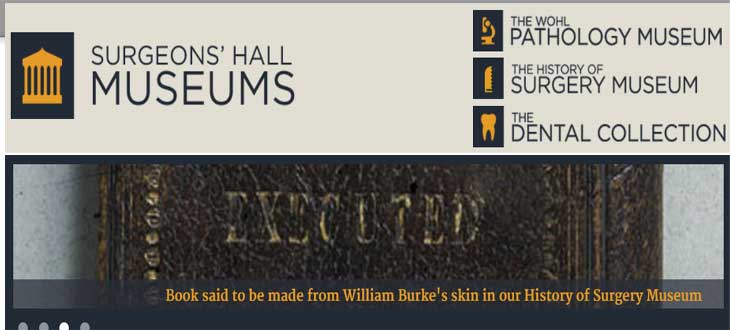
Its extensive pathology collection, as you might imagine, has some thought-provoking items – “natural and artificial curiosities” in their own words
Among Its best-known exhibits are the death mask of William Burke and a small book made from his skin, gruesome reminders of the notorious murderers Burke and Hare.
You might think that it is an adult-only place, but no, there is much for children to do and learn. The interactive and audio-visual elements do help.
This notice is a stark reminder of surgical advances.
“Are you brave enough to face amputation without anaesthetic? Before 1847. You didn’t have a choice.”
Royal college of Surgeons
Surgeons’ Hall also offers an outdoors Blood and Guts tour of Edinburgh’s Old Town.
Visit the official Surgeons Hall website for more information.
15) Jupiter Artland
Of all the unusual things to see in Edinburgh, Jupiter Artland might well be the most surprising. Located just a few miles outside Edinburgh this wonderful green space is a contemporary sculpture park, a description, which given all that’s on offer, seems inadequate.
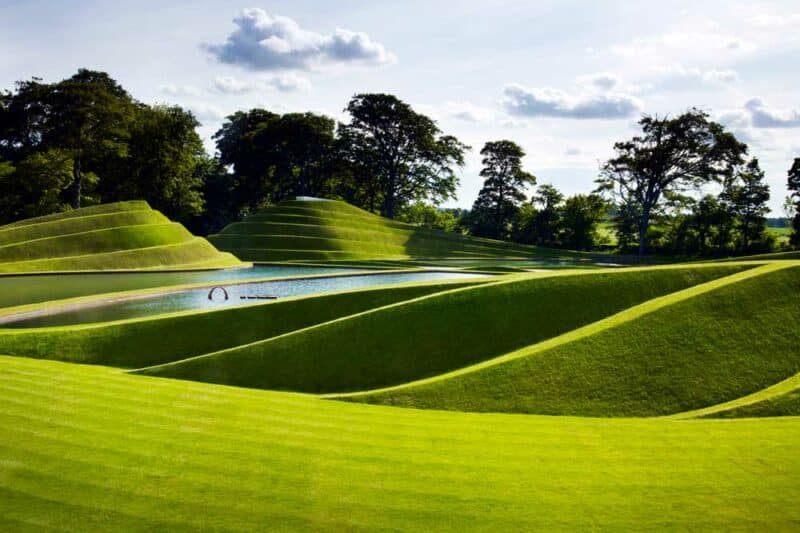
Some have described it as a garden, a museum or a gallery.
This wonderful family-friendly place is all of the above and so much more.
This feature article on Truly Edinburgh says more about this remarkable place.
16) Parliament Hall
Parliament Hall which sits behind St Giles’ Cathedral on the Royal Mile is the site of Scotland’s original parliament which met before its dissolution in 1707.
Among the men who went about their business in this historic hall, which still has its original and very impressive hammerbeam roof, was Andrew Fletcher (the Patriot).
Because the building is now home to the Supreme Courts of Scotland and filled with busy lawyers, the best time to visit Parliament Hall is during one of the annual Scottish Courts Doors Open Days.
Not to be mistaken for Scotland’s new Holyrood parliament which opened in 1999.
You can find out more about Doors Open Days on the Supreme Court’s website.
For more information on the Act of Union in 1707 see this page from the UK Parliament.
17) St Triduana’s Chapel
St Triduana’s Chapel remains attached to Restalrig Parish Church and lies to the east of Edinburgh’s city centre.
Historic Environment Scotland says “The surviving monument at St Triduana’s comprises an unusual hexagonal chapel and wellhouse.” With that description, it fits in well with our list of unusual places to visit in Edinburgh.
This page from Historic Environment Scotland has more information.
18) Blair Street Underground Vaults
The Edinburgh Vaults which lie underneath the city’s South Bridge offer visitors something out of the ordinary.
Managed by Mercat Tours, which offers a range of tours, visitors will get a sense of life in 18th century underground Edinburgh.
This feature article on Truly Edinburgh has more information.
19) Malleny Garden
Malleny Garden is a National Trust for Scotland (NTS) Edinburgh Garden.
Situated in Balerno, around seven miles south west of the city centre, the garden is more unexpected than unusual.
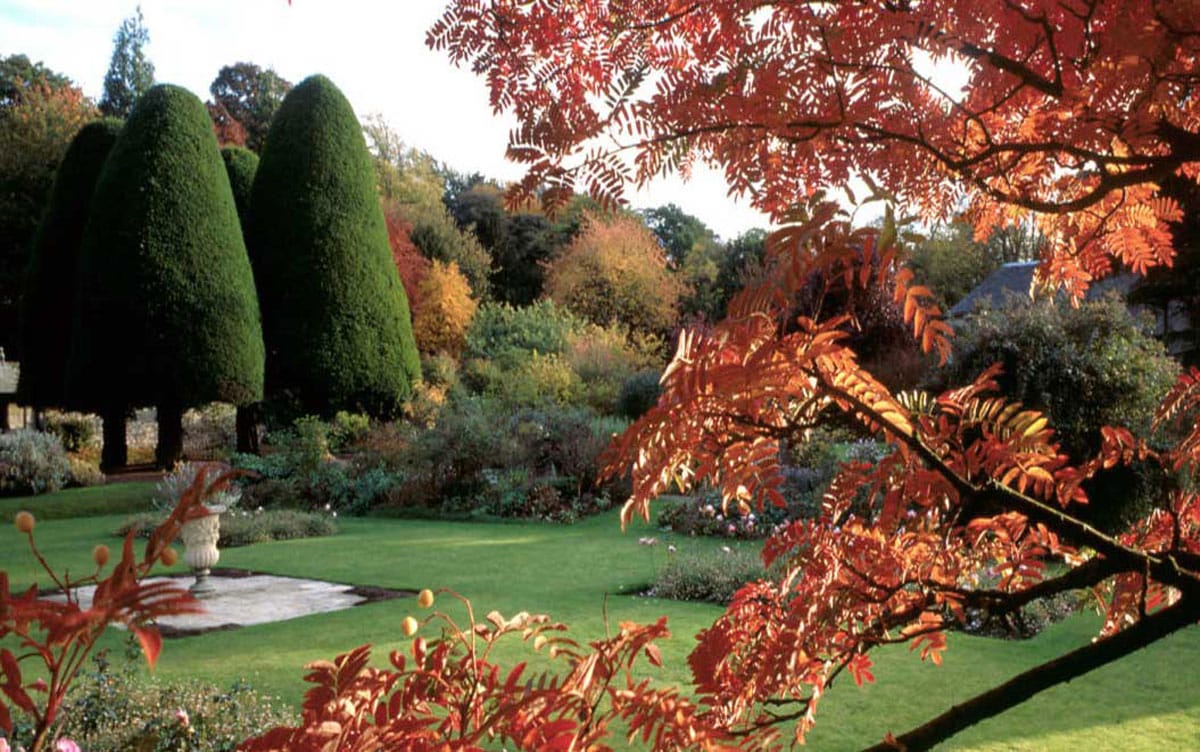
This article on Truly Edinburgh has more information about Malleny and other NTS properties in Edinburgh.
NTS call it a “hidden treasure amid the bustle of suburban Edinburgh.”
It’s the perfect reason for visiting.
20) James Hutton Memorial Garden
The James Hutton Memorial Garden takes its name from one of Edinburgh’s greatest scientists.
Managed by the Edinburgh Geological Society, it was built on the site of Hutton’s former home at St John’s Hill, a place he loved and where he wrote his best-known work Theory of the Earth.
With a great view of Arthur’s Seat, it’s not a garden, in the traditional sense, with plants and flowers. Instead, it’s filled with stones and rocks collected from around Scotland, an arrangement which befits the ‘father of modern geology’.
Hutton, co-founder, in 1783, of the Royal Society of Edinburgh and one of Edinburgh’s greatest Enlightenment figures is buried in Greyfriars Kirkyard.
See the Edinburgh Geological Society website for more information and helpful directions to what is not the easiest place to find.
21) Edinburgh Cast Collection
The Edinburgh Cast Collection is housed at Edinburgh College of Art, part of the University of Edinburgh.
The process of curating this remarkable collection of Antique, Renaissance, Gothic (and others) statues, frieze panels and other items, began in the late 18th century.
They were originally designed to train fine artists in Scotland.
Among this treasure trove are some Athenian casts including the ‘Elgin Set’, others modelled on the Parthenon, the figures of, Dione and Aphrodite, and Dionysus who was the god of wine and fertility.
But this is just the tip of the iceberg, there are so many more to see.
Items from the collection are often displayed at special exhibitions organised by the University.
The official University of Edinburgh website has more information.
22) Dunbar’s Close Garden
Dunbar’s Close Garden, named after 18th century Edinburgh writer David Dunbar, lies just a few steps from the busy Royal Mile.
It’s another of these Edinburgh places that come as a big surprise to visitors who stumble across it. Although relatively new in design it has the character of a much earlier creation.
Its benches and secluded spaces offer people the perfect spot to relax.
This feature article on Truly Edinburgh has much more information.
23) Chocolatarium
Edinburgh’s Chocolatarium, which also lies close to the Royal Mile is a wonderful place, particularly if you’re a lover of chocolate. Isn’t everybody?
A tour includes the chance to create your own bar of chocolate, make truffles, and try a chocolate and whisky or chocolate and wine pairing.
It’s a real hands-on experience, a great place for a children’s birthday party. There are over 40 flavours to taste.
Find all you need to know from the official website.
24) Witches’ Well
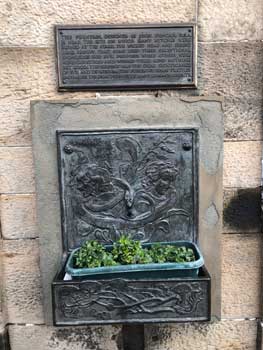
The Witches’ Well, a small fountain with plaque, is set into the wall of Edinburgh Castle esplanade. It marks the spot where over 300 people, mostly women, were burned at the stake.
The unfortunate victims were often first nearly drowned in the stinking waters of the Nor’ Loch, today drained and the site for Princes Street Gardens.
The accused were tied and thrown into the Nor’ Loch – if they drowned, they were believed to be free of evil spirits; but
If they survived the ordeal they were promptly burned at the stake, many on the nearby Castlehill.
More people were burned on Castlehill than in any other part of the country. Some were strangled before the pyre was lit – were they the ‘lucky’ ones?
The plaque reads, “This Fountain, designed by John Duncan R.S.A is near the site on which many witches were burned at the stake.”
“The serpent has the dual significance of evil and wisdom. The foxglove spray further emphasises the dual purpose of many common objects.”
anon
The wicked head and serene head signify that some used their exceptional knowledge for evil purposes while others were misunderstood and wished their kind nothing but good.